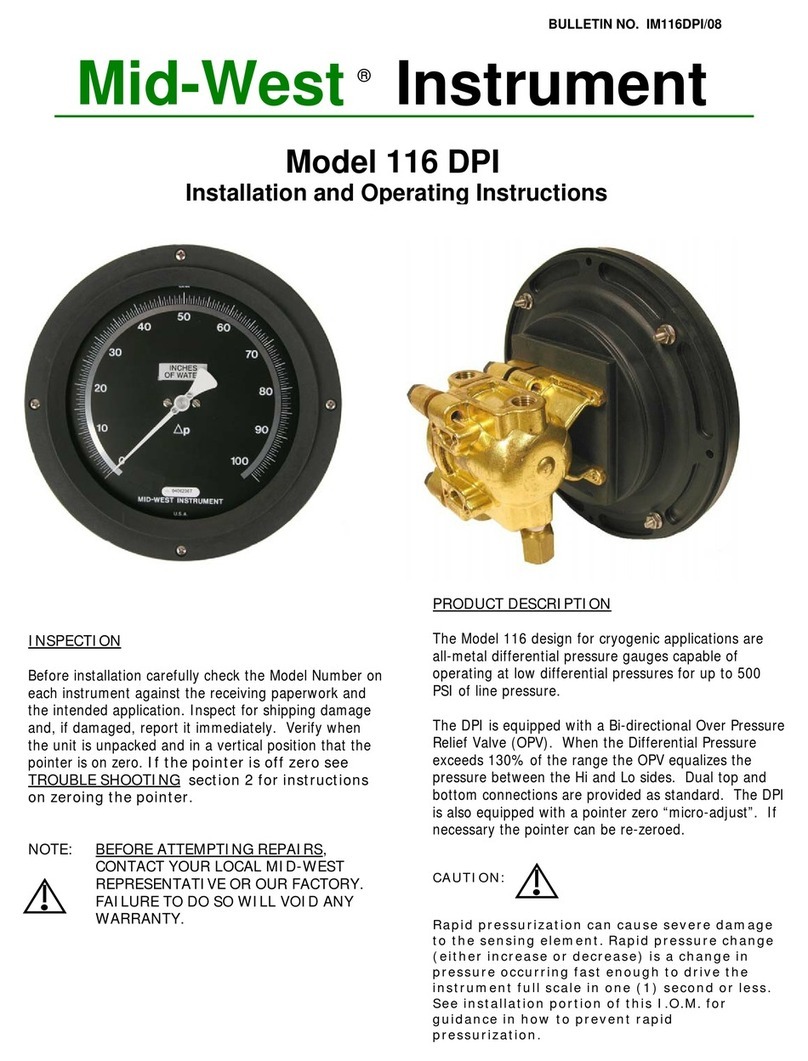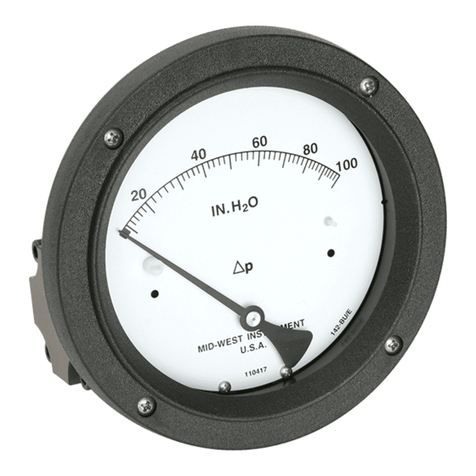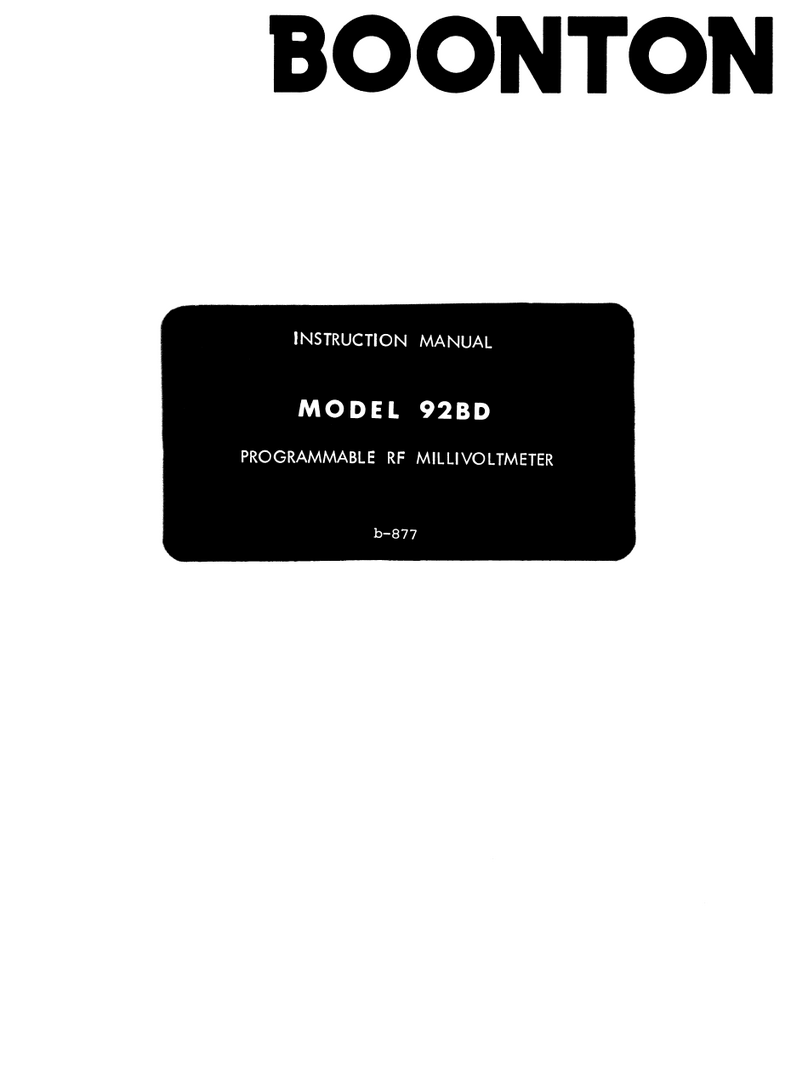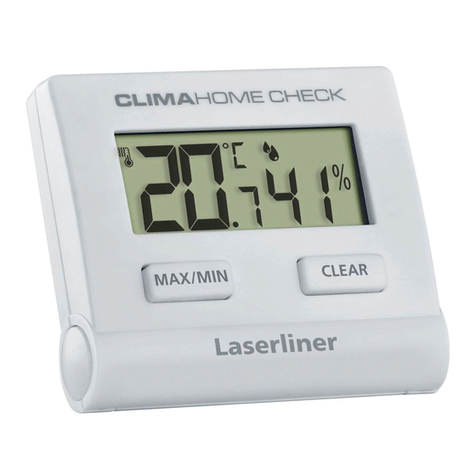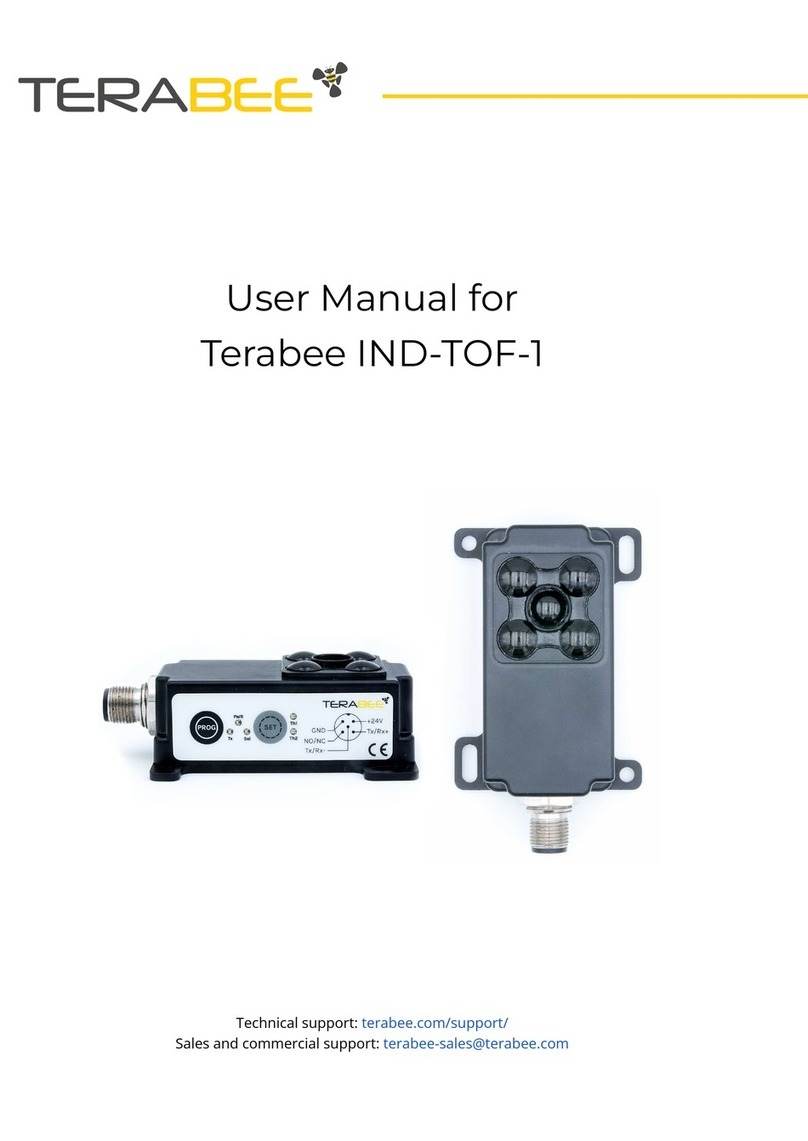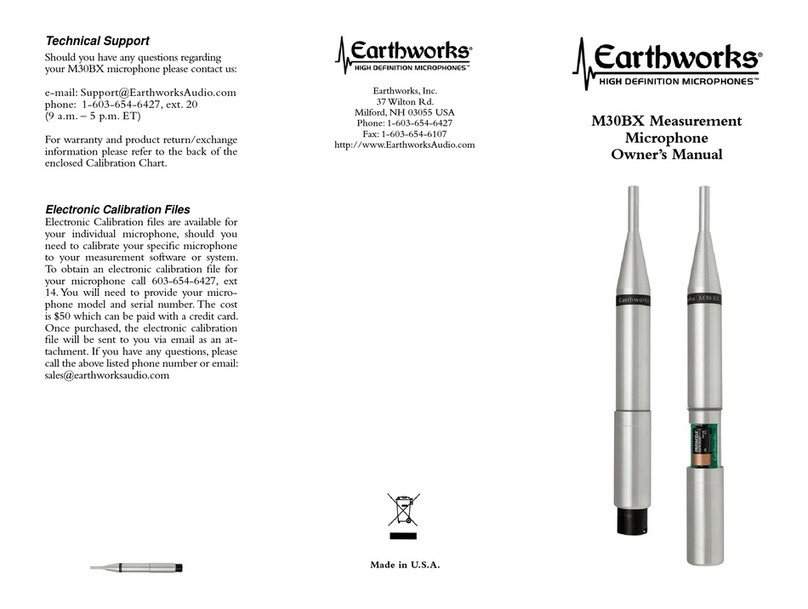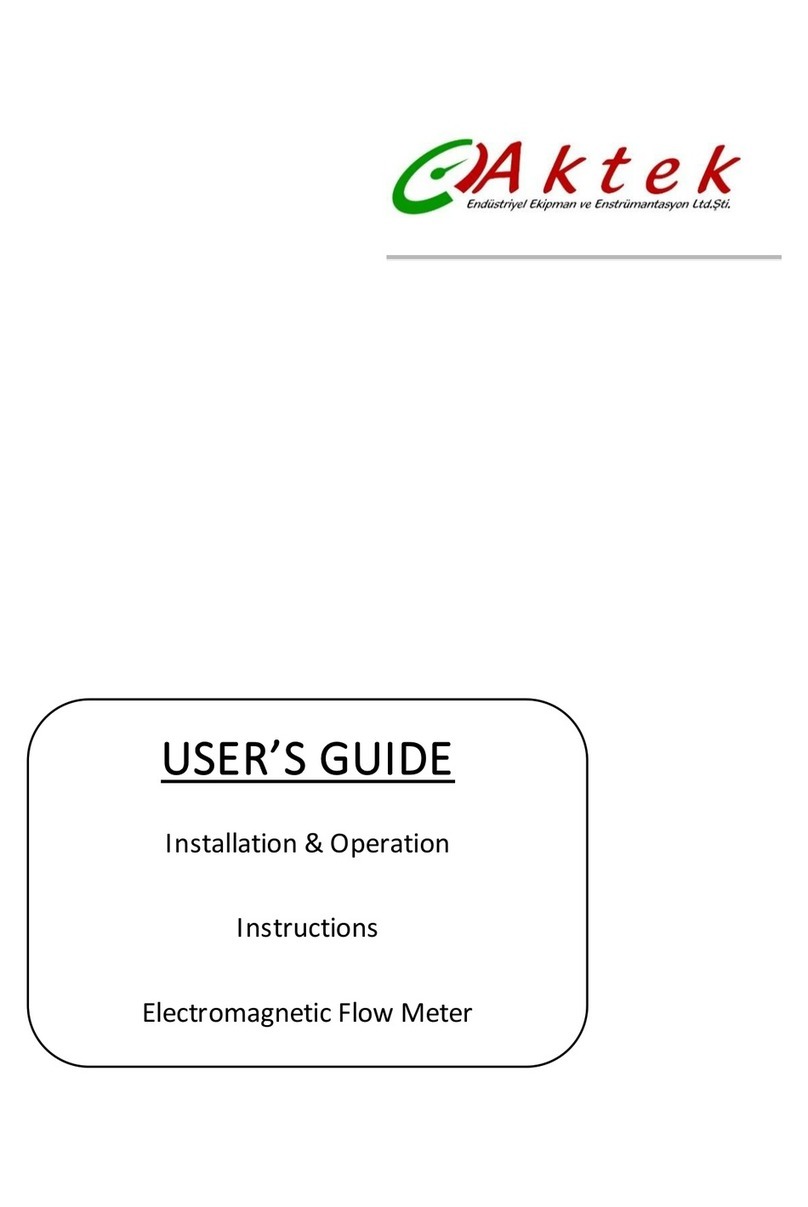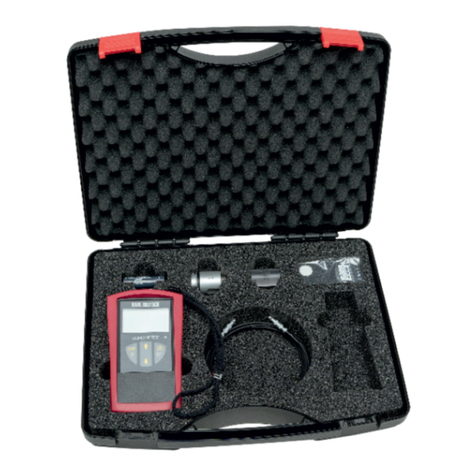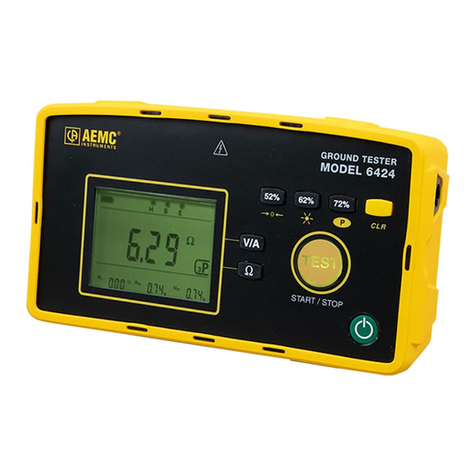Midwest Model 220 Technical specifications

Installation & Maintenance Instructions
Model 220
Hazardous Locations Division Classified
Electrical Configurations: A,B, J, & K
Reading Office
Cutbush Park, Danehill, Lower Earley,
Reading, Berkshire. RG6 4UT. UK.
Tel: +44 (0)118 9311188
Email: [email protected]
Aberdeen Office
Unit 6 Airside Business Park, Kirkhill Industrial Estate,
Dyce, Aberdeen. AB21 0GT. UK.
Tel: +44 (0)1224 725999
Email: [email protected]
Internet: www.able.co.uk
e-procurement: www.247able.com
Registered in England No: 01851002
VAT No: GB 417 2481 61

BULLETIN NO.ELEC IM220 ATEX/12A
Supersedes IM220 ATEX/11A
Instrument
Mid-West
®
ELECTRICAL
Upon receipt of your order, please review the ratings plate to
verify that the model number and the electrical ratings match
the product that you ordered. Electrical configuration option
R & S units are CE marked in accordance with the ATEX
directive. In addition the units will carry 3rd party markings
per the Division classification system. Please read the
Cautions listed on the Rating Plate as they are different
for each Electrical Configuration. The markings and
warnings identified on each plate are applicable only to
their respective Hazardous Locations classifications. Ie;
if the assembly is installed in an ATEX classified
location, then the ATEX ratings plate shall govern.
FIGURE 1
FIGURE 2
WARNING: This product should be installed by
personnel trained in installation of
equipment in Hazardous Locations and
meet the representative country’s National
Electrical Code.
WARNING: Electrostatic Hazard: Clean all exposed
plastic surfaces with a damp cloth. Do not
use solvents
WARNING: Failure to connect to the protective
conductor terminal may result in a shock
hazard.
WARNING: To meet Hazardous Location’s
Requirements, torque the cover bolts to the
specified values on the Ratings plate.
WARNING: The maximum gap permitted between the
body and cover is less than the maximum
permitted in the standard. Therefore it is the
responsibility of the user of this equipment
to ensure the maximum gap between the
body and the cover is not greater than
0.038mm (0.0015’’).
CAUTION: Do not scratch, nick, or dent mating
surfaces of the gauge body and the cover
during maintenance. The integrity of the
flame-proof enclosure is dependent upon
this metal to metal seal.
If cover bolts are lost or damaged, they
SHALL be purchased from Mid-West
Instrument for replacement. The bolts are
non-standard and have been designed
specifically for the referenced Hazardous
Locations in this document.
Clean Metal joint area with non-abrasive
cloth after any maintenance activity that
requires the cover to be removed. A small
amount of non-hardening grease may be
applied in the joint area.
In dust environments some minor surface
layering may occur. Routine cleaning shall
be performed for removal of the dust layer.
DIVISION 1 LOCATIONS:
Electrical Configurations R & S are 3rd Part Certified for
Class 1, Division 1, Groups B, C & D; Class 2, Division 1,
Groups E, F, & G Hazardous Locations. All Electrical
Specification Input & Output Combinations are approved
for this classification.
This configuration has T6 Temperature classification for all
input and output combinations except for the H input option
which has a T4A Temperature classification.
For Electrical Specification Input Option A in combination with
Output Options A through H, a seal is not required. This
configuration can also be classified as a “Simple Apparatus”
for use in an Intrinsically Safe System.
For Electrical Specification Input options B through H in
combination with Output option R, a seal is required within
18” of the enclosure. Please refer to National Electrical Code
requirements.
ATEX CERTIFIED
(Group II Category 2 Gas & Dust Atmospheres):
Electrical Configurations R & S are ATEX and IECEx
Certified for Gas & Dust Atmospheres as:
Ex d IIB + H
2
T 6 (-40ºC ≤Ta ≤70ºC)Gb
T 5(-40ºC < Ta < 85ºC)Gb
Ex tb IIIC IP65 T85ºC (-40ºC ≤Ta ≤70ºC)Db
T100ºC (-40ºC < Ta < 85º
C)Gb
II 2GD IP65
for Electrical input options A in combination with Electrical
Output options A, E, & H
Model 220 Electrical:
Installation and Operating Instructions

Ex d IIB + H
2
T 6 (-40ºC ≤Ta ≤70ºC)Gb
Ex tb IIIC IP65 T85ºC (-40ºC ≤Ta ≤70ºC)Db
II 2GD IP65
for Electrical input options A in combination with Electrical
Output options A, E, & H and input options B thru G in
combination with Output Option R
Ex d IIB + H
2
T 4 (-40ºC ≤Ta ≤70ºC)Gb
Ex tb IIIC IP65 T135ºC (-40ºC ≤Ta ≤70ºC)Db
II 2GD IP65
for Electrical input option H in combination with Electrical
Output option R
Installation
Tools Required: 8mm deep metric socket.
Torque wrench
Adjustable or 1.125” wrench (process
connections)
CAUTION: Do not exceed the maximum rated working
pressure stated on the ratings plate.
CAUTION: Always use a wrench (1.125”) on the
switch’s process connections to keep them
in place while loosening and tightening
customer supplied process fittings.
WARNING: Verify media compatibility with all wetted
parts. Range spring is manufactured from
316SS. Media incompatibility with the
spring or the body of the gauge can result in
an ignition hazard due to corrosion.
WARNING: Use pressure limiting devices to limit
pressure spikes below the proof pressure of
the gauge / switch.
Locate unit where temperatures will be within the limits of the
device hazardous’ locations ratings.
On liquid service the instrument should be mounted
below the process connections to facilitate self bleeding. On
gas service it should be located above the process
connections to promote self-draining. If the process contains
particulates, a “pigtail” loop or drop leg (manometer “U-tube”
configuration) in the tubing will minimize the possibility of it
migrating into the instrument. An optional pipe mounting kit is
available for mounting the gauge to a 2” vertical or horizontal
pipe.
A provision for special mounting is provided on the back of
the gauge.
Connect process piping or tubing to the pressure ports
stamped High and Low on the gauge body. Connections are
either ¼” FNPT or ½” FNPT dependent upon the option
selected when the order was placed.
Reverse pressure will not damage the instrument, however
the switch and indicator (if supplied) will not function properly.
CAUTION: Use cable suitable for the specified
temperature class. Maximum internal cable
entry temperature rise is 15 ºC – Cabling to
be suitable.
WARNING: Electrical connection shall be made with a
cable entry or stopping box certified for use
for the desired hazardous location, certified
for condition of use, and correctly installed.
The cable entry device and any thread
adaptor shall be suitable for the equipment,
the cable, and the conditions of use, and
shall be certified as equipment (Not an EC
component) under the EC Type Examination
Certificate to directive 94/9/EC.
WARNING: When used in an explosive dust
atmosphere, the cable entry device and
thread adaptor shall maintain the ingress
protection of the enclosure.
WARNING: During maintenance do not disconnect from
external earth conductor until all power
generation systems have been turned off.
WARNING: In Hazardous Locations remove power from
the unit before removing the cover.
WARNING: Do not touch the surface of the printed
circuit board if the unit is powered. High
Voltage may be present.
Remove the cover by using an 8mm hex driver to loosen the
bolts from the underside of the gauge body. (see previous
cautions and warnings). The bolts are captive in the body of
the gauge. A deep metric socket is recommended in order to
clear an interference near the bezel of the gauge. (0.48
diameter min 1” long).
Connections to the terminal strip are identified in the following
sections. The terminal strip is compatible for wire ranges
from 12-22 AWG ( 3.3 - .32 mm
2
). Optionally, each
connection can be field wired with multiple wires connected
to one contact. You may connect two (2) 22 – 16 AWG (0.33
-1.3 mm
2
) wires into one connection. Recommended screw
torque is 6 in. lbs. (0.113 newton-meter) to tighten the
terminal strip screw.
Each Assembly is provided with strain relief clamps. Use
these clamps to provide strain relief when field wiring the
instrument.
For the non-gasketed assembly, clean both mating metal
surfaces prior to re-assembly (see previous cautions and
warnings). A small application of a suitable, non-hardening
grease may be applied to the mating metal surfaces.
Replace cover making sure there are no wires pinched
between the cover and the gauge body. Re-tighten the
screws within the range of 60 to 75 in-lbs.

Switch Configurations:
The Model 220 indicating / non-indicating differential
pressure switch is configured with one of the outputs
identified in the table below.
OUTPUT RATINGS (Resistive Load)
Type SPST SPDT SPDT DPDT
Relay
ELEC Spec. A A A B,C,D,E,F,
G, H
Output
Option Code
E, F, or G H A R
*Power 60 W 60 W 3W N/A
Max. Current
3 Amps 1.0 Amps 0.25 Amps 10 Amps
Max. Volts
VAC/ VDC
240 240 125 277 / 30
Setting
(F.S.)
15% to 90%
25% to 90%
10% to 90%
15% to 90%
Hysterisis
(Max/Nom)
20% / 9%
Full
Scale(F.S.)
20% / 18%
Full
Scale(F.S.)
10% / 6%
Full
Scale(F.S.)
20% / 10%
Full
Scale(F.S.)
Repeatability
1% F.S. 1% F.S. 1% F.S. 1% F.S.
Table I
* Product of the switching voltage and current shall not
exceed the power rating of the device.
Hermetically Sealed Switch Outputs:
Electrical Specification Input Option “A” identifies that your
unit does not need input power to operate the switch output
and that your unit is equipped with Hermetically Sealed Reed
switches. The “A” option matched with Output Options A, E,
& H identifies the output capability of your unit. Depending on
the electrical configuration specified on the order (A, B, R, or
S), your unit will be equipped with 1 or 2 independently
adjustable reed switches.
Interface to the 16 position terminal strip shown in Figure 3 is
defined in Table II.
Terminal Connections
Electrical
Options
Qty
Sw. Function Switch Adjust
Low Port
Switch Adjust
Hi Port
RAA, RAH 1 SPDT 1(COM), 2(NO),
3 (NC) No Connection
SAA, SAH 2 SPDT 1(COM), 2(NO)
3 (NC)
8(COM), 7(NO)
6 (NC)
RAE 1 SPST
NO 1,2 No Connection
RAF 1 SPST
NC 1,3 No Connection
SAE 2 SPST
NO 1,2 8,7
SAF 2 SPST
NC 1,3 8,6
SAG 2 SPST 1
NO, 1NC 1, 3 NC 8, 7 NO
Table II
Chassis connection is to position 12 or 13.
Customer Interface for the Reed Switch Output Option will be
via connections 1 through 8 and connections 12 or 13. Do
not loosen the connections at positions 9, 10, 11, 14, 15 , or
16.
All switch types are field adjustable. The defined range of the
adjustment is specified in Table I above. All switches come
with a decal to identify adjustment direction to increase the
set point. Do not use excessive force when rotating the
adjustment screw as the adjustment mechanism may be
damaged (See Figure 4).
Note: Switches can be set below the defined minimum set
point however, the switch may not remain activated at
maximum PSID. If the unit is set below the defined minimum
set point, the customer should verify that the switch remains
activated from the set point to full over range of the gauge.
Provide standard protection techniques for the switch
contacts for capacitive and inductive loads. Use current
limiting techniques near the switch to protect the contacts
due to high inrush (i.e.; in line resistor or inductor) for long
cable interfaces. Provide clamping devices at or near
inductive loads (i.e.; relay). Maximum wire length between
the 3W switch and its load, should not exceed 70 – 100
Feet. for 120 VAC applications. Contact the factory for
assistance regarding this condition.
FIGURE 4
Figure 3: Reed Switch Terminal Strip Output Interface
Customer
Interface
Low
Port
High
Port
Switch
Adjust
Low Port
High Port
Pro
tective
Terminal

Simple Apparatus:
Electrical configurations R & S in combination with Input
option A, in combination with output options A, E, F,G or H
are classified as “Simple Apparatus” when used in
Intrinsically Safe circuits. These configurations comply with
EN50020:2002 clause 5.4. In addition, per the agreement of
CENELEC sub-committee SC31-3, simple apparatus do not
fulfill the definition in Article 1 of Directive 94/9/EC and
therefore fall outside the scope of the Directive. Also, they do
not require a declaration of conformity or CE mark related to
this directive.
If the product is used as “Simple Apparatus within a
Hazardous atmosphere please note the following items:
1) The switch shall be installed by personnel trained in
the installation of equipment in Hazardous Locations.
2) The configurations classified as intrinsically safe have
no source of internal heating. For temperature
classification, take into account the temperature of
the process and the maximum temperature specified
in this document.
3) It is the responsibility of the user to identify that the
installed device is identified as a “Simple Apparatus”
device. For the identified configurations it is possible
that for an intrinsic safe system that the switch could
be installed in a location outside of the Hazardous
Locations marking identified on the ratings plates(s)
Relay Output Interface
Electrical Specification Input Option “B” through “H” identifies
that your unit will need input power to operate the relay
output (output option R). Depending on the electrical
configuration specified on the order (R or S) your unit will be
equipped with 1 DPDT output or 2 independently adjustable
SPDT Relay outputs. Table I identifies the load ratings and
the adjustability range of the output.
Interface to the 16 position terminal strip shown in Figure 5 is
defined in Table III.
The relay outputs are uncommitted and may be connected to
any load provided the load is within the output ratings of the
relay. The terminal strip is compatible with 22 – 12 Awg. wire.
Deviations from the above configurations may exist.
Therefore check the description block of your order to verify
your configuration.
FIGURE 6
FIGURE 5
Terminal Connections
Switch Adjust
Lo Port
Switch Adjust
Hi Port
Electrical
Options
Qty
Sw. Func.
Com NO NC Com NO NC
R*R, 1 DPDT 1
9
2
10
3
11
X X
X
S*R, 2 SPDT
1
2
3
8
7 6
TABLE III
* = Input Power Options B, C, D, E, F, G, & H
Input Power = Position 4 + for DC; Hot for AC
Position 5 Rtn. for DC, Neutral for AC
Connection 13
See Decal on Inside Cover for additional connection
information.
Reed Sw Output
Relay Output
(AC Input0
Relay Output:
(DC Input)

TROUBLE SHOOTING
1. Gauge does not indicate differential.
A. Check for proper hook up, high to “hi” and low
to “lo”.
B. Make certain block valves are open and, if using
a 3-valve manifold, that the equalizer (balance)
valve is closed.
C. If A & B check out correctly, loosen or disconnect
the high pressure line to determine if there is
pressure to the instrument.
D. If there is pressure to the instrument, check to
determine that there is differential across the
unit being monitored. If so, contact the factory
for assistance and/or an “RGA” (return goods
authorization) number to return the instrument
for repair or replacement.
2. Switch doesn't function
A. Make sure you have supplied power (proper voltage)
to the unit if you ordered the power relay unit. The
reed switch output units do not require power.
B. Check that you are wiring to the correct Interface
terminals.
C. Check the reed switch interfaces to the terminal board
for loose connections. For the power relay the reed
switch(es) connect to the terminal strip on the
underside of the PCB. For the reed switch outputs the
reed switch(es) connect to positions on the bottom row
of the terminal strip on the top of the PCB (see Figure
4).
D. Make sure that the switch load does not exceed the
specified wattage rating of the switch. (steady-
state and transient). For this condition you must
contact the factory
3. Gauge accuracy and set point problems:
A. Verify gauge is not in an electromagnetic /
magnetic environment. i.e.; close proximity to high
current power lines.
B. All others, contact the factory for assistance
FIGURE 6

STANDARD MODEL SPECIFICATIONS
220-AC-02-0(RAA), 3000 P.S.I.G. Working Pressure, Aluminum wetted pressure containing body assembly, stainless steel/ceramic
magnet internals, Buna N Seals, 4 1/2" Round Dial, 1/4" FNPT End Connections, Engineering Plastic Gauge Case with Shatter
Resistant Acrylic Lens. One 3W, 0.25 AMP, 125 VAC/VDC SPDT Reed Switch with terminal strip in an Aluminum Explosion-proof
switch enclosure with 1/2" FNPT Electrical Access ATEX Certified
220-SC-02-0(RAA), 3000 P.S.I.G. Working Pressure, 316 S.S. wetted pressure containing body assembly, , stainless steel/ceramic
magnet internals, Buna N Seals, 4 1/2" Round Dial, 1/4" FNPT End Connections, Engineering Plastic Gauge Case with Shatter
Resistant Acrylic Lens. One 3W, 0.25 AMP, 125 VAC/VDC SPDT Reed Switch with terminal strip in an Aluminum Explosion-proof
switch enclosure with 1/2" FNPT Electrical Access. ATEX Certified
PART NUMBERING SYSTEM
1. BASIC MODEL NUMBER
2. MATERIAL
S. Aluminum Body, 316 S.S. Bore,
S.S. Piston
Z. Special
10
3. DIAL SIZE
(Engineering Plastic Housing Unless Stated)
C. 4-1/2” Round Dial Uni-Directional Dial
F. 4-1/2” Round Aluminum Dial Housing
T. Differential Pressure Switch Only (Without Indication)
Z. Special (Uncoded Options)
10
4.
SEALS
0. Buna N (Standard)
1. *Viton®
2. Neoprene
5. Ethylene Propylene
6. Perfluoroelastomer
9. Special (Uncoded Options)
10
5.
CONNECTIONS
2. 1/4" FNPT End Connections (Standard)
7. 1/2” FNPT End Connected
9. Special (Uncoded Options)
10
6.
OPTIONS
(Up to four options)
0. None
B. DIN2353 12-S (12 mm) Steel Tube Fittings (2)
F. Pipe Mounting Kit (Carbon Steel)
G. Pipe Mounting Kit (Stainless Steel)
M. Maximum Indicator Follower Pointer
10
Q. CRN (Canadian Registration Number)
S. Shatterproof lens (4 1/2 Metal Front Only).
T. Oxygen Cleaning
U. S.S. Tag with S.S. Wire
V. S.S. Tag with S.S. Screw
Y. S.S. End Fittings with Al Body (Material Option A)
Z. Special (Uncoded Options)
10
NOTE: Not all options available in combination with
Other options.
* Viton® is a Registered Trademark of DuPont Dow Elastomers
7.
ELECTRICAL CONFIGURATIONS (Select One)
(Switch Adjustable Range 10-90% except where stated
below) (T6 Temperature Class unless specified otherwise)
A. One Control Switch in NEMA4X Enclosure
1,6,8
B. Two (2) Control Switches in NEMA4X Enclosure
1,6,7,8
J. One (1) Control Switch in NEMA7 (Exp. Proof Encl.)
2
K. Two (2) Control Switches in NEMA7 (Exp. Proof Encl.)
2,7
R. One (1) Control Switch in Ex d encl. ( CE Marked)
2,9
S. Two (2) Control Switches in Ex d encl. (CE Marked)
2,7,9
.
Z. Special
10
8.
ELECTRICAL
SPECIFICATIONS (Select 1 Input and 1
Output)
INPUT OPTIONS:
A. No Input Power (For Reed Outputs A, E, F, G, H)
B. 5/6 VDC
C. 12 VDC
D. 24 VDC
E. 48 VDC
F. 24 VAC
G. 120 VAC
H. 240 VAC
(FOR H OPTION T4-ATEX; T4A NORTH AMER.) TEMP CLASS
9.
OUTPUT OPTIONS: (Resistive Load)
3
A. S.P.D.T., Reed, 3 W, 0.25 Amp, 125 VAC/VDC
E. S.P.S.T., Reed, 60 W, 3 Amp, 240 VAC/VDC (N.O.)
(4)
F. S.P.S.T., Reed, 60 W, 3 Amp, 240 VAC/VDC (N.C.)
(4)
G. Two (2) S.P.S.T., Reeds, 60 W, 3 Amp, 240 VAC/VDC
(One Normally Open, One Normally Closed B, K & S
Electrical Configurations Only)
(4)
H. S.P.D.T., Reed, 60 W, 1 Amp, 240 VAC / VDC
(5)
R. D.P.D.T. Relay, 10 A, @ 30 VDC, 120 / 240 VAC
(4)(8)
Z. Special (Contact Factory)
10
(1) Complete Assembly 3rd Party Certified, Rated Class I, Div II, Groups
A,B,C, & D; Class II Division II, Groups F & G. (R Output option
excluded)
(2) Complete Assembly 3rd Party Certified, Rated Class I, Div I, Groups B C,
& D; Class II Division I, Groups E, F, & G.
(3) For output options A through H, the product of the switching
voltage and current shall not exceed the power rating.
(4) Switch adjustable range 15 – 90 % of the gauge full scale range.
(5) Switch adjustable range 25 – 90 % of the gauge full scale range.
(6) Enclosure Type 4/4X
(7) For Electrical configurations B, K, & S SPDT relay output only.
(8) Electrical configuration A & B in combination with Output Option R
is not rated
for hazardous locations.
(9) ATEX / IECEx RATED; CE MARKED Ex d IIB + H2, Ex tb IIIC
II 2GD IP65 (Temp classifications vary dependent on Electrical
Input and Output options. See IM 220_atex for more detail),
(10) Not available with Electrical Configurations R & S.
2
2
0
R RELAY
OUTPUT OPTION

PROOF PRESSURE: 12,000
WORKING PRESSURE: 3000 PSI
TEMPERATURE LIMITS:
- 40ºC < Ta < 70ºC for output option R (Relay Output).
- 40ºC < Ta < 85ºC for Electrical Input Options A in combination with Electrical Output options A, E,F,G & H.
- These limits are based on the entire instrument being saturated to these temperatures. System (process) temperatures may
exceed these limitations with proper installation. Contact our customer service representative for details.
STANDARDS: The Model 220 Series differential pressure gauges either conform to and/or are designed to the requirements
of the following standards:
ASME B1.20.1 ASME B40.1
NEMA Std. No. 250 SAE J514
CSA-C22.2 No. 14, 25, and 30 EN60079-0, EN60079-1
UL Std. No. 50, 508, 698, and 1203 EN60079-31, EN13463-1
Pressure Equipment Directive:
The products manufactured by Mid-West Instrument have very small internal volumes. The small internal volumes
result in Mid-West Instrument products falling below category I for non-hazardous gases, hazardous liquids, and
non-hazardous liquids. They also fall below category I for hazardous gases at or below pressures of 200 bar. Per
article 3, paragraph 3 these products shall not bear the CE marking and shall be designed and manufactured with
“sound engineering practice”. Our sound engineering practice is supported by our quality system in accordance
with CSA B51-03 Annex F third party certified by QMI.
Applications for hazardous gases at pressures above 200 bar will require evaluation to the Pressure Equipment
Directive which may be performed in the future.
Warning:
The suitability of the application and installation of this differential pressure switch is the
responsibility of the end user. The applicable certifications, listings apply to the differential
pressure switch only.
Mid-West
Instrument
6500 Dobry Dr. Sterling Heights, MI 48314
(586)254-6500 FAX (586)254-6509
E-Mail: sales@midwestinstrument.com
Web Page: www.midwestinstrument.com

BULLETIN NO.ELEC IM220/11A
Supersedes: Elec IM220/10A
Instrument
Mid-West®
ELECTRICAL
Upon receipt of your order, please review the ratings plate to
verify that the model number and the electrical ratings match
the product that you ordered. Figure 1 is the ratings plate for
Electrical Configuration J or K (Division 1 approval) and
Figure 2 is the Rating Plate for Electrical Configuration A or
B (Division 2 approval). Please read the Cautions listed on
the Rating Plate as they are different for each Electrical
Configuration.
FIGURE 1
FIGURE 2
WARNING: IN HAZARDOUS LOCATIONS REMOVE
POWER FROM THE UNIT BEFORE
REMOVING THE COVER.
WARNING: DO NOT TOUCH SURFACE OF THE
PRINTED CIRCUIT BOARD IF THE UNIT IS
POWERED. HIGH VOLTAGE MAY BE
PRESENT.
WARNING: ELECTRICAL CONNECTIONS SHOULD
BE PERFORMED BY QUALIFIED
PERSONNEL AND MEET THE
REPRESENTATIVE COUNTRY'S
NATIONAL ELECTRICAL CODE.
WARNING: FAILURE TO CONNECT TO THE
PROTECTIVE CONDUCTOR TERMINAL
MAY RESULT IN A SHOCK HAZARD.
DIVISION 1 LOCATIONS:
Electrical Configurations J & K are 3rd Party Certified for
Class 1, Division 1, Groups B,C & D; Class 2, Division 1,
Groups E, F, & G Hazardous Locations. All Electrical
Specification Input & Output Combinations are approved
for this classification. This enclosure does not have a
NEMA 4X rating.
This configuration has T6 Temperature classification for all
input and output combinations except for the H input option
which has a T4A Temperature classification.
For Electrical Specification Input Option A in combination with
Output Options A through H, a seal is not required. This
configuration can also be classified as a “Simple Apparatus”
for use in an Intrinsically Safe System.
For Electrical Specification Input options B through H in
combination with Output option R, a seal is required within
18” of the enclosure. Please refer to National Electrical Code
requirements.
Caution: Do not scratch, nick, or dent mating surfaces
of the gauge body and the cover during
maintenance. The integrity of the flame-proof
enclosure is dependent upon this metal to
metal seal.
If cover bolts are lost contact Mid-West
Instrument for Replacement.
Clean Metal joint area with non-abrasive cloth
after any maintenance activity that requires
the cover to be removed. A small amount of
non-hardening grease may be applied in the
joint area.
WARNING: To meet Hazardous Location’s Requirements,
torque the cover bolts to the specified values
on the Ratings plate.
DIVISION 2 LOCATIONS:
Electrical Configurations A & B (without Relay Output) are
3rd Party Certified for Class I, Division 2, Groups A, B, C, &
D; Class 2, Division 2 Groups F & G Hazardous Locations.
Only Electrical Specification Input Option A in
combination with Output Options A through H are
approved for this location. This enclosure does have a
NEMA 4X rating.
This configuration has a T6 Temperature classification.
This configuration can also be classified as a “Simple
Apparatus” for use in an intrinsically safe System.
Note: The assembly may be ordered with a relay output
and NEMA 4X rating; however it will not carry a 3rd party
certification for use in Hazardous Locations.
Model 220 Electrical: Installation and Operating Instructions
Hazardous Locations Division Classified Electrical Configurations: A,B, J, & K

General Information:
FIGURE 3
Switch Configurations:
The Model 220 indicating / non-indicating differential
pressure switch is configured with one of the outputs
identified in the table below.
OUTPUT RATINGS (Resistive Load)
Type SPST SPDT SPDT DPDT
Relay
ELEC Spec. A A A B,C,D,E,F,
G, H
Output
Option Code E, F, or G H A R
*Power 60 W 60 W 3W N/A
Max. Current 3 Amps 1.0 Amps 0.25 Amps 10 Amps
Max. Volts
VAC/ VDC 240 240 125 277 / 30
Setting
(F.S.) 15% to 90% 25% to 90% 10% to 90% 15% to 90%
Hysteresis
(Max/Nom) 20% / 9%
Full
Scale(F.S.)
20% / 18%
Full
Scale(F.S.)
10% / 6%
Full
Scale(F.S.)
20% / 10%
Full
Scale(F.S.)
Repeatability 1% F.S. 1% F.S. 1% F.S. 1% F.S.
Table I
* Product of the switching voltage and current shall not
exceed the power rating of the device.
Hermetically Sealed Switch Outputs:
Electrical Specification Input Option “A” identifies that your
unit does not need input power to operate the switch output
and that your unit is equipped with Hermetically Sealed Reed
switches. The “A” option matched with Output Options A, E,
F, G, & H identifies the output capability of your unit.
Depending on the electrical configuration specified on the
order (A, B, J, or K), your unit will be equipped with 1 or 2
independently adjustable reed switches.
Interface to the 16 position terminal strip shown in Figure 1 is
defined in Table II.
Terminal Connections
Electrical
Options Qty
Sw. Function Switch Adjust
Low Port Switch Adjust
Hi Port
AAA, JAA,
AAH, JAH 1 SPDT
1(COM), 2(NO),
3 (NC) No Connection
BAA, KAA,
BAH, KAH 2 SPDT
1(COM), 2(NO)
3 (NC) 8(COM), 7(NO)
6 (NC)
AAE, JAE 1 SPST
NO 1,2 No Connection
AAF, JAF 1 SPST
NC 1,3 No Connection
BAE, KAE 2 SPST
NO 1,2 8,7
BAF, KAF 2 SPST
NC 1,3 8,6
BAG, KAG 2 SPST 1
NO, 1NC 1, 3 NC 8, 7 NO
Table II
Chassis connection is to position 13
Customer Interface for the Reed Switch Output Option will be
via connections 1 through 8 and connections 12. Do not
loosen the connections at positions 9, 10, 11, 13 14, 15 , or
16.
Figure 4: Reed Switch Terminal Strip Output Interface
Custome
r
Interface
Low
Port High
Port

All switch types are field adjustable. The defined range of the
adjustment is specified in Table I above. All switches come
with a decal to identify adjustment direction to increase the
set point. Do not use excessive force when rotating the
adjustment screw as the adjustment mechanism may be
damaged (See Figure 5).
FIGURE 5
Note: Switches can be set below the defined minimum set
point however, the switch may not remain activated at
maximum PSID. If the unit is set below the defined minimum
set point, the customer should verify that the switch remains
activated from the set point to full over range of the gauge.
Provide standard protection techniques for the switch
contacts for capacitive and inductive loads. Use current
limiting techniques near the switch to protect the contacts
due to high inrush (i.e.; in line resistor or inductor) for long
cable interfaces. Provide clamping devices at or near
inductive loads (i.e.; relay). Maximum wire length between
the 3W switch and its load, should not exceed 70 – 100
Feet. for 120 VAC applications. Contact the factory for
assistance regarding this condition.
Relay Output Interface
Electrical Specification Input Option “B” through “H” identifies
that your unit will need input power to operate the relay
output (output option R). Depending on the electrical
configuration specified on the order (A, B, J, or K) your unit
will be equipped with 1 DPDT relay output or 2 independently
adjustable SPDT relay outputs. Table I identifies the load
ratings and the adjustability range of the output.
Interface to the 16 position terminal strip shown in Figure 6 is
defined in Table III.
The relay outputs are uncommitted and may be connected to
any load provided the load is within the output ratings of the
relay. The terminal strip is compatible with 22 – 12 Awg. wire.
Deviations from the above configurations may exist.
Therefore check the description block of your order to verify
your configuration.
FIGURE 6
FIGURE 6
Terminal Connections
Switch Adjust
Low Port Switch Adjust
Hi Port
Electrical
Options Qty
Sw. Func. Com NO NC Com NO NC
A*R, J*R 1 DPDT 1
9 2
10 3
11 X X X
B*R **,
K*R 2 SPDT 1 2 3 8 7 6
TABLE III
* = Input Power Options B, C, D, E, F, G, & H
** = NOT CSA / UL Listed configuration
Input Power = Position 4 + for DC; Hot for AC
Position 5 Rtn. for DC, Neutral for AC
Connections 13
See Decal on Inside Cover for additional connection
information.
Switch Output:
Relay Output:
(AC Input)
Relay Output:
(DC Input)
HIGH PORT
LOW PORT

INSTALLATION
Tools Required: 8mm deep metric socket.
Torque wrench
Adjustable or 1.125” wrench (process
connections)
CAUTION: DO NOT EXCEED THE MAXIMUM RATED
WORKING PRESSURE STATED ON THE
RATINGS PLATE.
CAUTION: ALWAYS USE A WRENCH (1.125” ) ON THE
SWITCH’S PROCESS CONNECTIONS TO
KEEP THEM IN PLACE WHILE TIGHTENING
AND LOOSENING CUSTOMER SUPPLIED
PROCESS FITTINGS.
Model 220 Series "Filter Minder" is calibrated and tested prior
to shipment and is ready for immediate installation. Use of
the following installation procedures should eliminate
potential damage and provide optimum trouble-free
operation.
CONNECTIONS
1/4” FNPT are provided as standard however check your
paperwork for connections ordered. There are two
connections on the housing identified as “High” and “Low” for
high pressure and low pressure (Fig. 5). Be sure these get
plumbed to the proper connections on your system. Improper
connection will not damage the instrument, but it will not
function properly. Flexible tubing is recommended to
minimize the effect of any vibration that may exist.
On liquid service the instrument should be mounted
below the process connections to facilitate self bleeding. On
gas service it should be located above the process
connections to promote self-draining. If the process contains
particulates, a “pigtail” loop or drop leg (manometer “U-tube”
configuration) in the tubing will minimize the possibility of it
migrating into the instrument.
An optional pipe mounting kit is available for mounting the
gauge to a 2” vertical or horizontal pipe (Fig. 3).
WARNING: IN HAZARDOUS LOCATIONS REMOVE
POWER FROM THE UNIT BEFORE
REMOVING THE COVER.
WARNING: DO NOT TOUCH SURFACE OF THE
PRINTED CIRCUIT BOARD IF THE UNIT IS
POWERED. HIGH VOLTAGE MAY BE
PRESENT.
Remove the cover by using an 8mm hex driver to loosen the
bolts from the underside of the gauge body. (see previous
cautions and warnings). The bolts are captive in the body of
the gauge. A deep metric socket is recommended in order to
clear an interference near the bezel of the gauge. (0.48
diameter min 1” long).
Connections to the terminal strip are identified in the following
sections. The terminal strip is compatible for wire ranges
from 12-22 AWG ( 3.3 - .32 mm2). Optionally, each
connection can be field wired with multiple wires connected
to one contact. You may connect two (2) 22 – 16 AWG (0.33
-1.3 mm2) wires into one connection. Recommended screw
torque is 6 in. lbs. (0.113 newton-meter) to tighten the
terminal strip screw.
Each Assembly is provided with strain relief clamps. Use
these clamps to provide strain relief when field wiring the
instrument.
For the non-gasketed assembly, clean both mating metal
surfaces prior to re-assembly (see previous cautions and
warnings). A small application of a suitable, non-hardening
grease may be applied to the mating metal surfaces.
Replace cover making sure there are no wires pinched
between the cover and the gauge body. Re-tighten the
screws within the range of 60 to 75 in-lbs.
TROUBLE SHOOTING
1. Gauge does not indicate differential.
A. Check for proper hook up, high to “hi” and low
to “lo”.
B. Make certain block valves are open and, if using
a 3-valve manifold, that the equalizer (balance)
valve is closed.
C. If A & B check out correctly, loosen or disconnect
the high pressure line to determine if there is
pressure to the instrument.
D. If there is pressure to the instrument, check to
determine that there is differential across the
unit being monitored. If so, contact the factory
for assistance and/or an “RGA” (return goods
authorization) number to return the instrument
for repair or replacement.
2. Switch doesn't function
A. Make sure you have supplied power (proper voltage)
to the unit if you ordered the power relay unit. The
reed switch output units do not require power.
B. Check that you are wiring to the correct Interface
terminals.
C. Check the reed switch interfaces to the terminal board
for loose connections. For the power relay the reed
switch(es) connect to the terminal strip on the
underside of the PCB. For the reed switch outputs the
reed switch(es) connect to positions on the bottom row
of the terminal strip on the top of the PCB (see Figure
4).
D. Make sure that the switch load does not exceed the
specified wattage rating of the switch. (steady-
state and transient). For this condition you must
contact the factory
3. Gauge accuracy and set point problems:
A. Verify gauge is not in an electromagnetic /
magnetic environment. i.e.; close proximity to high
current power lines.
B. All others, contact the factory for assistance.

STANDARD MODEL SPECIFICATIONS
220-AC-02-0(JAA), 4000 P.S.I.G. Working Pressure, Aluminum wetted pressure containing body assembly, stainless steel/ceramic
magnet internals, Buna N Seals, 4 1/2" Round Dial, 1/4" FNPT End Connections, Engineering Plastic Gauge Case with Shatter
Resistant Acrylic Lens. One 3W, 0.25 AMP, 125 VAC/VDC SPDT Reed Switch with terminal strip in an Aluminum Explosion-proof
switch enclosure with 1/2" FNPT Electrical Access 3rd Party Certified .
220-SC-02-0(JAA), 4000 P.S.I.G. Working Pressure, 316 S.S. wetted pressure containing body assembly, , stainless steel/ceramic
magnet internals, Buna N Seals, 4 1/2" Round Dial, 1/4" FNPT End Connections, Engineering Plastic Gauge Case with Shatter
Resistant Acrylic Lens. One 3W, 0.25 AMP, 125 VAC/VDC SPDT Reed Switch with terminal strip in an Aluminum Explosion-proof
switch enclosure with 1/2" FNPT Electrical Access. 3rd Party Certified
PART NUMBERING SYSTEM
1. BASIC MODEL NUMBER
2. MATERIAL
A. Aluminum Body, Aluminum Bore ,
S.S. Piston
S. Aluminum Body, 316 S.S. Bore,
S.S. Piston
Z. Special
3. DIAL SIZE (Engineering Plastic Housing Unless Stated)
C. 4-1/2” Round Dial Uni-Directional Dial
F. 4-1/2” Round Aluminum Dial Housing
T. Differential Pressure Switch Only (Without Indication)
Z. Special (Uncoded Options)
4.SEALS
0. Buna N (Standard)
1. *Viton®
2. Neoprene
5. Ethylene Propylene
6. Perfluoroelastomer
9. Special (Uncoded Options)
5. CONNECTIONS
2. 1/4" FNPT End Connections (Standard)
7. ½” FNPT End Connections
9. Special (Uncoded Options)
6. OPTIONS (Up to four options)
0. None
F. Pipe Mounting Kit (Carbon Steel)
G. Pipe Mounting Kit (Stainless Steel)
M. Maximum Indicator Follower Pointer
Q. CRN (Canadian Registration Number)
S. Shatterproof Lens (4 1/2" Metal Front Only)
T. Oxygen Cleaning
U. S.S. Tag with S.S. Wire
V. S.S. Tag with S.S. Screw
Y. S.S. End Fittings with Al Body (Material Option A)
Z. Special (Uncoded Options)
NOTE: Not all options available in combination with
Other options.
* Viton® is a Registered Trademark of DuPont Dow Elastomers
** Teflon® is a Registered Trademark of DuPont
7.ELECTRICAL CONFIGURATIONS (Select One)
(Switch Adjustable Range 10-90% except where stated
below) (T6 Temperature Class unless specified otherwise)
A. One Control Switch in NEMA4X Enclosure1,6,8
B. Two (2) Control Switches in NEMA4X Enclosure 1,6,7,8
J. One (1) Control Switch in NEMA7 (Exp. Proof Enclosure) 2
K. Two (2) Control Switches in NEMA7 (Exp. Proof Enclosure) 2
R.
S.
Z. Special
8. ELECTRICAL SPECIFICATIONS (Select 1 Input and 1
Output)
INPUT OPTIONS:
A. No Input Power (For Reed Outputs A, E, F, G, H)
B. 5/6 VDC
C. 12 VDC
D. 24 VDC
E. 48 VDC
F. 24 VAC
G. 120 VAC
H. 240 VAC T4A Temp Class
9. OUTPUT OPTIONS: (Resistive Load) 3
A. S.P.D.T., Reed, 3 W, 0.25 Amp, 125 VAC/VDC
E. S.P.S.T., Reed, 60 W, 3 Amp, 240 VAC/VDC (N.O.)(4)
F. S.P.S.T., Reed, 60 W, 3 Amp, 240 VAC/VDC (N.C.)(4)
G. Two (2) S.P.S.T., Reeds, 60 W, 3 Amp, 240 VAC/VDC
(One Normally Open, One Normally Closed B, K & S
Electrical Configurations Only) (4)
H. S.P.D.T., Reed, 60 W, 1 Amp, 240 VAC / VDC(5)
R. D.P.D.T. Relay, 10 A, @ 30 VDC, 120 / 240 VAC (4)(8)
Z. Special (Contact Factory)
(1) Complete Assembly 3rd Party Certified, Rated Class I, Div II, Groups
A,B,C, & D; Class II Division II, Groups F & G. (R Output option
excluded)
(2) Complete Assembly 3rd Party Certified, Rated Class I, Div I, Groups B C,
& D; Class II Division I, Groups E, F, & G.
(3) For output options A through H, the product of the switching
voltage and current shall not exceed the power rating.
(4) Switch adjustable range 15 – 90 % of the gauge full scale range.
(5) Switch adjustable range 25 – 90 % of the gauge full scale range.
(6) Enclosure Type 4/4X
(7) For Electrical configurations B, K, & S SPDT relay output only.
(8) Electrical configuration A & B in combination with Output Option R
is not rated for hazardous locations.
2
2
0
2
2
0
R RELAY
OUTPUT OPTION

PROOF PRESSURE: 16,000 PSI
WORKING PRESSURE: 4000 PSI
TEMPERATURE LIMITS: -40F (-40C) TO + 185F (+85C)** - These limits are based on the entire instrument being
saturated to these temperatures. System (process) temperatures may exceed these limitations with proper installation. Contact
our customer service representative for details.
** -40F (-40C) TO + 160F (+70C) For Output Option R (Relay Output)
STANDARDS: The Model 220 Series differential pressure gauges either conform to and/or are designed to the requirements
of the following standards:
ASME B1.20.1 UL Std. No. 50, 508, 698, and 1203
ASME B40.1 NEMA Std. No. 250
CSA-C22.2 No. 14, 25, and 30 SAE J514
Warning: The suitability of the application and installation of this differential pressure switch is the
responsibility of the end user. The applicable certifications, listings apply to the differential
pressure switch only.
Mid-West
Instrument
6500 Dobry Dr. Sterling Heights, MI 48314
(586)254-6500 FAX (586)254-6509
E-Mail: [email protected]
Web Page: www.midwestinstrument.com
Table of contents
Other Midwest Measuring Instrument manuals
Popular Measuring Instrument manuals by other brands
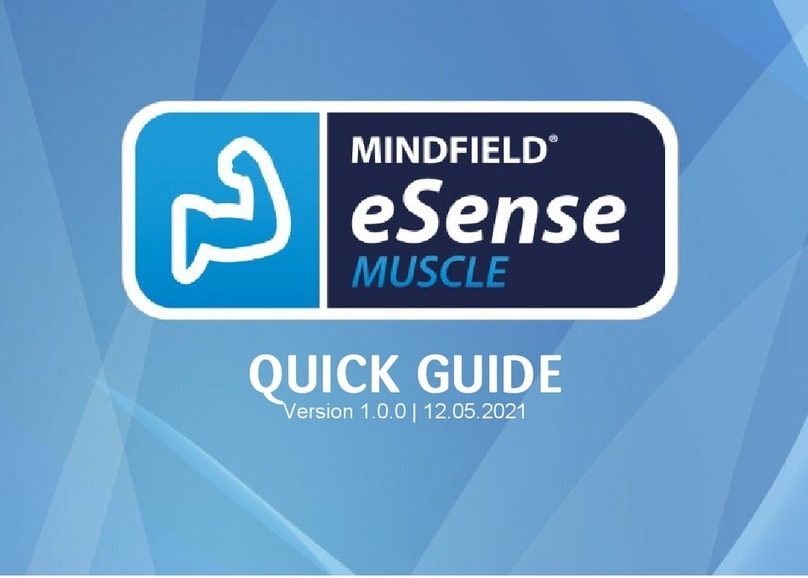
Mindfield
Mindfield eSense Muscle quick guide
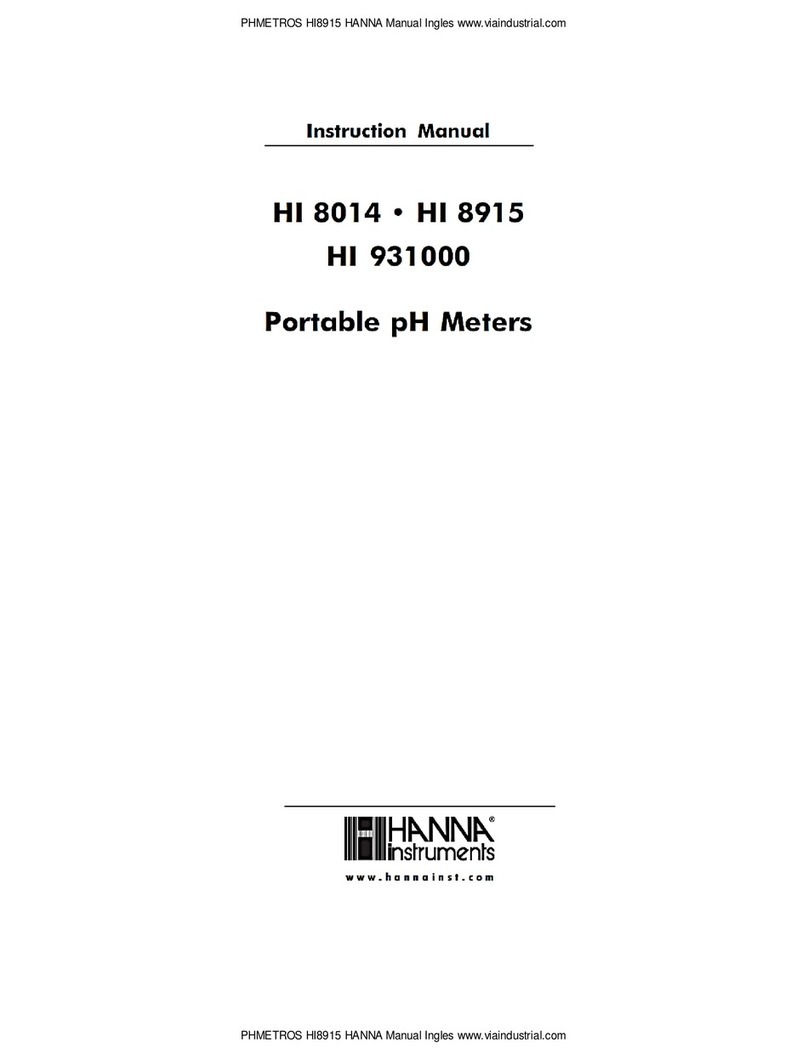
Hanna Instruments
Hanna Instruments HI 8014 instruction manual

Secure
Secure APEX 100 user manual
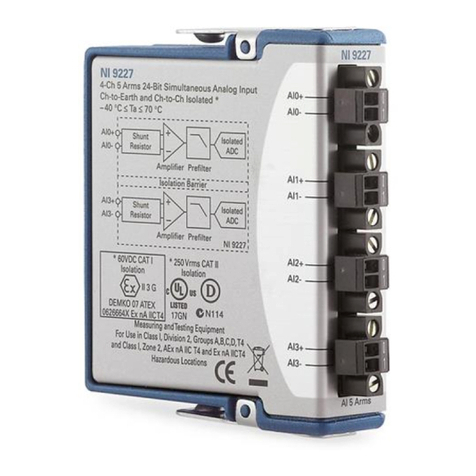
National Instruments
National Instruments NI 9227 CALIBRATION PROCEDURE
Onicon
Onicon F-4600 Series Installation and operation guide
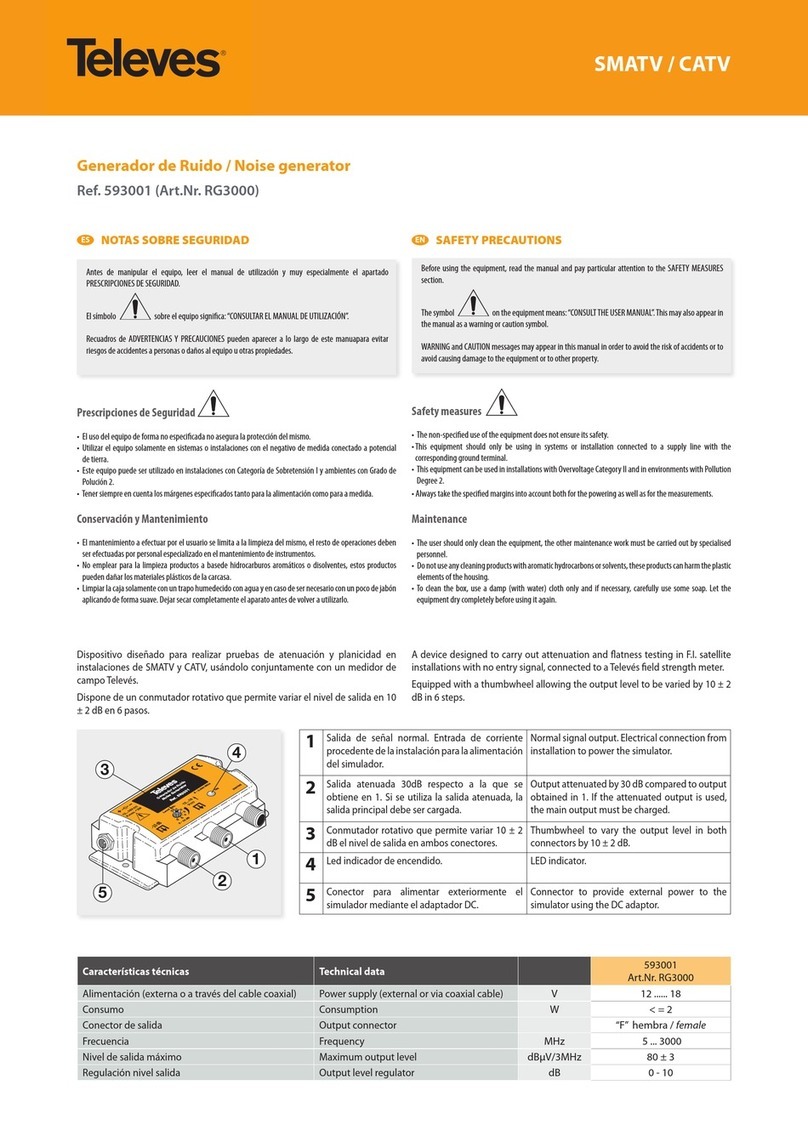
Televes
Televes RG3000 quick start guide
